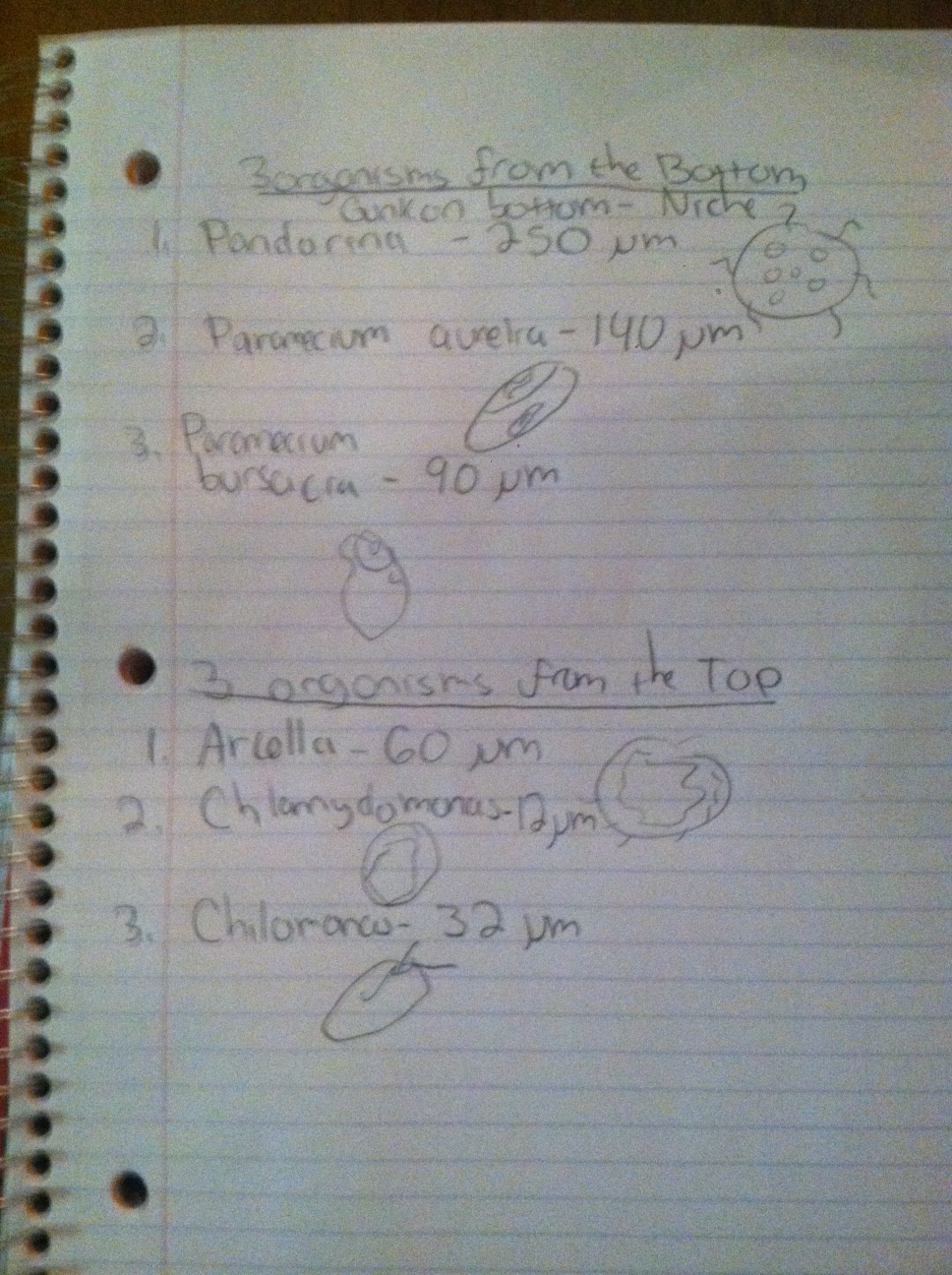User:Jessica Kerpez/Notebook/Biology 210 at AU: Difference between revisions
No edit summary |
No edit summary |
||
| Line 26: | Line 26: | ||
If the Hay Infusion Culture was observed for another two months, I would expect to see an increase in the amount of mold/algae, and an increase in the amount of organisms living in it because of an increase in bacteria. | If the Hay Infusion Culture was observed for another two months, I would expect to see an increase in the amount of mold/algae, and an increase in the amount of organisms living in it because of an increase in bacteria. The color of the culture would darken as more matter built up, and the smell would become increasingly potent. | ||
There is the selective pressure of the search for food and nutrients for the organisms living in the Hay Infusion culture. They are competing for these resources available, as well as mating with various organisms. | There is the selective pressure of the search for food and nutrients for the organisms living in the Hay Infusion culture. They are competing for these resources available, as well as mating with various organisms. For instance, if there is a limited amount of plant matter only the fittest organisms can survive. | ||
[[Image:Serial Dilutions.jpg]] | |||
Revision as of 14:54, 9 February 2014
February 9th, 2014
LAB 2: Identifying Algae and Protists
There was a clear transformation in our Hay Infusion Culture. The smell of the culture was musky and foul. There was a layer of film that had developed at the top of the jar. There was a thick layer of sludge that was resting at the bottom of the jar, and small spots of green mold.
Organisms near vs away from the plants will different because the species in the area are exposed to two different environments. Species that live far away from the plant may eat the mold that is resting on the bottom of the jar, while species near the plant could feed upon the plant matter.
We got our samples from the top film layer and from the sludge resting at the bottom:
3 Organisms from Bottom Niche- Gunk on Bottom 1. Pandorina- 250 micrometers, green algae, pandorina genus, mobile using flagella. 2. Paramecium Aurelia-140 micrometers, paramecium genus, mobile using cilia. 3. Paramecium Busaria- 90 micrometers, protozoan, paramecium genus, mobile-mobile.
3 Organisms from Top Niche-top film layer of water 1. Arcella- 60 micrometers, Arcella genus, mobile 2. Chlamydomonas- 12 micrometers, green algae, Chlamydomonas genus, mobile with flagella 3. Chilomonas - 32 micrometers, chryptophyte, protozoa, chilomonas genus, mobile with flagella
- these organisms do not photosynthesize
Chosen species: Paramecium Aurelia
A Paramecium is a heterotroph, and it gets its food from nutrients within the hay infusion culture (like algae).Paramecium is a genus of unicellular ciliate protozoa. Paramecium move using their cilia and spiral throughout the water. They use a large amount of energy to propel through water. This paramecium reproduces asexually through a process called binary fission.
If the Hay Infusion Culture was observed for another two months, I would expect to see an increase in the amount of mold/algae, and an increase in the amount of organisms living in it because of an increase in bacteria. The color of the culture would darken as more matter built up, and the smell would become increasingly potent.
There is the selective pressure of the search for food and nutrients for the organisms living in the Hay Infusion culture. They are competing for these resources available, as well as mating with various organisms. For instance, if there is a limited amount of plant matter only the fittest organisms can survive.
J.K
1.31.14
LAB 1
Describe the general characteristics of the transect: location, topography, etc. : The transect was located in a grassy area in the middle of two of three large trees near the Washington Seminary. On either side of the grassy area covered in dirt, leaves, and sticks stood two tall trees. The ground was completely covered in leaves because they had fallen from the large trees. The ground and soil was slightly damp from rainfall. In the middle of these two trees was a picnic table and a small, round tennis ball. We also witnessed a small yellow-crested bird perch upon one of the tall trees.
List the abiotic and biotic components:
Abiotic: Tennis ball, picnic table, soil
Biotic: Trees, leaves, bird
Table 1 Evolutionary Specialization of Members of the Volvocine Line
Characteristic Chlamydomonas Gonium Volvox
Number of cells 2 3 1
Colony size 6 5 1
special function motile still still
reproduction specialization isogamy oogamy oogamy
J.K.

